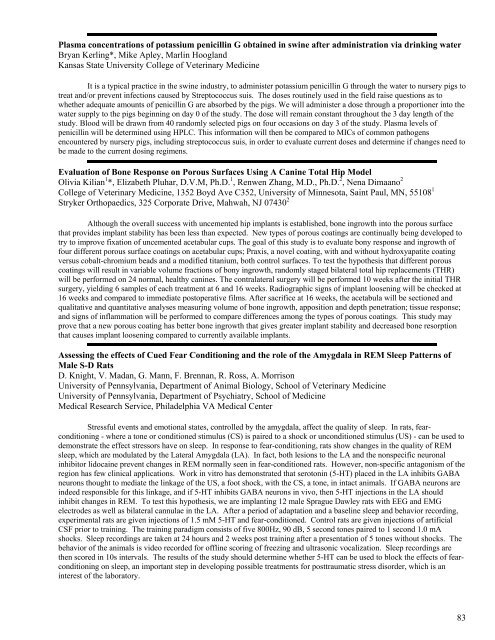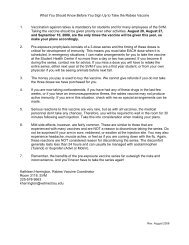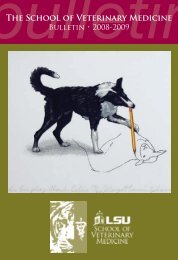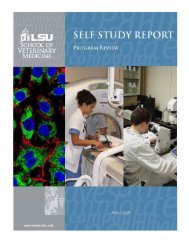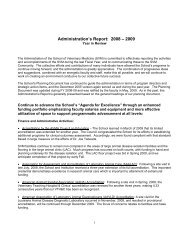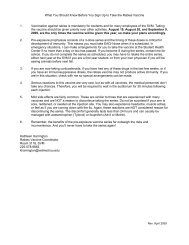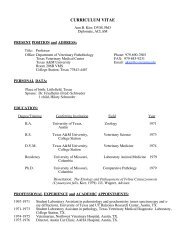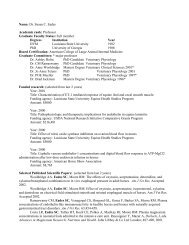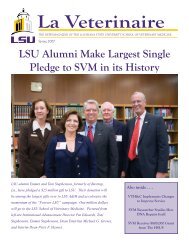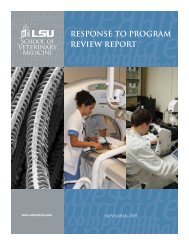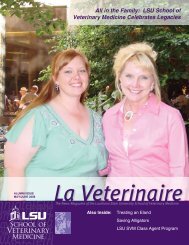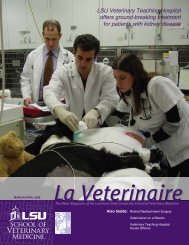Equine Ho<strong>of</strong> Laminae Tissue Collection via BiopsyBrenna Hanly, Ashley Stokes, Jill Johnson<strong>School</strong> <strong>of</strong> <strong>Veterinary</strong> <strong>Medicine</strong>, <strong>Louisiana</strong> <strong>State</strong> University. Baton Rouge, LAEquine laminitis is a major concern in the industry. Laminitis is a severely debilitating, extremely painful, andpotentially life-threatening disease <strong>of</strong> the laminae <strong>of</strong> the equine digit. Most research <strong>of</strong> equine laminitis unfortunatelyinvolves euthanasia <strong>of</strong> the animal in order to collect ho<strong>of</strong> laminar tissue samples to analyze. We conducted a study to collectlaminar tissues from normal horses via biopsy through the ho<strong>of</strong> wall. Samples were collected from horses to determine if thistechnique could be viable for future studies and clinical applications. Multiple samples were taken at different time intervalsto determine if this technique could be conducted in a research setting requiring samples at several time intervals. A maingoal was to determine if after one sample is taken, if inflammation would affect future sampling. Also, skin tissue sampleswere collected from above the coronary band in conjunction with the ho<strong>of</strong> biopsies to analyze similarities. Samples wereanalyzed using light microscopy. Additionally, total RNA quantification and qualification were determined. Laminae andskin biopsies were obtainable and the procedure yielded adequate specimens for histological and molecular biologicalanalysis. Statistically, there were no patterns <strong>of</strong> inflammation seen with serial samples. The results <strong>of</strong> this study canhopefully be used in future research as a way to collect laminar samples without euthanasia.Evaluation <strong>of</strong> Freeze-dried Platelet Preparations for the Improvement <strong>of</strong> Wound Healing in Horses.Sara Hogle* BS, Naomi Walker BS, Jeffrey W. Norris PhD, Verena Affolter DVM, PhD, and Jorge Nieto DVM,PhD, and Fern Tablin VMD, PhDTablin Laboratory, Department <strong>of</strong> Anatomy, Physiology and Cell Biology, <strong>School</strong> <strong>of</strong> <strong>Veterinary</strong> <strong>Medicine</strong>,University <strong>of</strong> California, Davis, Davis, CA, United <strong>State</strong>s, 95616.Distal limb wounds <strong>of</strong> horses are challenging to treat, <strong>of</strong>ten becoming chronic, non-healing wounds. A recent studydemonstrated that treatment with fresh platelet gels accelerated healing (Carter et al. 2003). Our laboratory developed aprotocol for loading equine platelets with trehalose, a disaccharide which stabilizes the cells during freeze-drying. Trehalosestabilized freeze-dried platelets were analyzed for the presence <strong>of</strong> platelet growth factors and were compared with serum andfresh trehalose-loaded platelets. Quantitative ELISAs demonstrated preservation <strong>of</strong> PDGF (65%) and TGFâ-1(58%) <strong>of</strong> serumcontent. Freeze-dried platelet supernatants also significantly improved fibroblast proliferation, contraction <strong>of</strong> fibroblastseeded collagen gels, and enhanced migration <strong>of</strong> fibroblasts in a scratch assay. We propose that this preparation can be usedto improve equine limb wound healing. To test this hypothesis, twelve forelimbs on six horses will receive standardized (2.5x 2.5cm) full-thickness skin wounds and will be treated with one <strong>of</strong> four randomly selected treatments: 1)standardized semiocclusivebandaging, 2) fresh autologous platelet gel, 3) freeze-dried buffer (control), and 4) autologous, trehalose stabilizedfreeze-dried platelets. We will evaluate the following parameters <strong>of</strong> wound healing: the degree <strong>of</strong> granulation tissue,vascularization, time to first epithelialization, rate <strong>of</strong> contraction, changes in wound size and days to wound closurethroughout the healing process to complete re-epithelialization. Additionally microscopic evaluation will determine thepresence <strong>of</strong> dermal-epidermal rate, the presence <strong>of</strong> adnexial structures and the reorganization <strong>of</strong> the dermal matrix. Theresults <strong>of</strong> this study will provide insights into the role <strong>of</strong> platelets and platelet gels in wound healing, and may culminate inthe development <strong>of</strong> a shelf stable treatment useful for field veterinarians.Evaluation <strong>of</strong> Gene Expression in Whole Blood <strong>of</strong> Osteoarthritic and Normal HorsesThomas E. Kellerman*, David A. Wilson, Aaron M. StokerE. Paige Laurie Endowed Program in Equine Lameness, College <strong>of</strong> <strong>Veterinary</strong> <strong>Medicine</strong>, University <strong>of</strong> Missouri -ColumbiaThe matrix metalloproteinases, nitric oxide synthases, cyclooxygenases, prostaglandins, various cytokines, andaggrecan have been studied for their roles in inflammatory processes. Genome wide in vivo surveys <strong>of</strong> gene expression inhorses affected with osteoarthritis (OA) have yet to be completed. The purpose <strong>of</strong> this study is to evaluate gene expression inequine blood from horses affected with OA and horses that are not. As an equine specific microarray is not commerciallyavailable, a human array containing approximately 18,400 transcripts will be used. Blood from three horses with OA andtwo horses without OA will be collected. Messenger RNA will be extracted and amplified in preparation for hybridization.Each sample will be hybridized twice onto separate microarrays. Confirmation <strong>of</strong> cross species homology for transcripts <strong>of</strong>interest and quantification will be done using Real-Time PCR. It is hoped that the data from this pilot study will be useful inidentifying therapeutic targets as well as elucidating novel biomarkers for diagnostic tests.82
Plasma concentrations <strong>of</strong> potassium penicillin G obtained in swine after administration via drinking waterBryan Kerling*, Mike Apley, Marlin HooglandKansas <strong>State</strong> University College <strong>of</strong> <strong>Veterinary</strong> <strong>Medicine</strong>It is a typical practice in the swine industry, to administer potassium penicillin G through the water to nursery pigs totreat and/or prevent infections caused by Streptococcus suis. The doses routinely used in the field raise questions as towhether adequate amounts <strong>of</strong> penicillin G are absorbed by the pigs. We will administer a dose through a proportioner into thewater supply to the pigs beginning on day 0 <strong>of</strong> the study. The dose will remain constant throughout the 3 day length <strong>of</strong> thestudy. Blood will be drawn from 40 randomly selected pigs on four occasions on day 3 <strong>of</strong> the study. Plasma levels <strong>of</strong>penicillin will be determined using HPLC. This information will then be compared to MICs <strong>of</strong> common pathogensencountered by nursery pigs, including streptococcus suis, in order to evaluate current doses and determine if changes need tobe made to the current dosing regimens.Evaluation <strong>of</strong> Bone Response on Porous Surfaces Using A Canine Total Hip ModelOlivia Kilian 1 *, Elizabeth Pluhar, D.V.M, Ph.D. 1 , Renwen Zhang, M.D., Ph.D. 2 , Nena Dimaano 2College <strong>of</strong> <strong>Veterinary</strong> <strong>Medicine</strong>, 1352 Boyd Ave C352, University <strong>of</strong> Minnesota, Saint Paul, MN, 55108 1Stryker Orthopaedics, 325 Corporate Drive, Mahwah, NJ 07430 2Although the overall success with uncemented hip implants is established, bone ingrowth into the porous surfacethat provides implant stability has been less than expected. New types <strong>of</strong> porous coatings are continually being developed totry to improve fixation <strong>of</strong> uncemented acetabular cups. The goal <strong>of</strong> this study is to evaluate bony response and ingrowth <strong>of</strong>four different porous surface coatings on acetabular cups; Praxis, a novel coating, with and without hydroxyapatite coatingversus cobalt-chromium beads and a modified titanium, both control surfaces. To test the hypothesis that different porouscoatings will result in variable volume fractions <strong>of</strong> bony ingrowth, randomly staged bilateral total hip replacements (THR)will be performed on 24 normal, healthy canines. The contralateral surgery will be performed 10 weeks after the initial THRsurgery, yielding 6 samples <strong>of</strong> each treatment at 6 and 16 weeks. Radiographic signs <strong>of</strong> implant loosening will be checked at16 weeks and compared to immediate postoperative films. After sacrifice at 16 weeks, the acetabula will be sectioned andqualitative and quantitative analyses measuring volume <strong>of</strong> bone ingrowth, apposition and depth penetration; tissue response;and signs <strong>of</strong> inflammation will be performed to compare differences among the types <strong>of</strong> porous coatings. This study mayprove that a new porous coating has better bone ingrowth that gives greater implant stability and decreased bone resorptionthat causes implant loosening compared to currently available implants.Assessing the effects <strong>of</strong> Cued Fear Conditioning and the role <strong>of</strong> the Amygdala in REM Sleep Patterns <strong>of</strong>Male S-D RatsD. Knight, V. Madan, G. Mann, F. Brennan, R. Ross, A. MorrisonUniversity <strong>of</strong> Pennsylvania, Department <strong>of</strong> Animal Biology, <strong>School</strong> <strong>of</strong> <strong>Veterinary</strong> <strong>Medicine</strong>University <strong>of</strong> Pennsylvania, Department <strong>of</strong> Psychiatry, <strong>School</strong> <strong>of</strong> <strong>Medicine</strong>Medical Research Service, Philadelphia VA Medical CenterStressful events and emotional states, controlled by the amygdala, affect the quality <strong>of</strong> sleep. In rats, fearconditioning- where a tone or conditioned stimulus (CS) is paired to a shock or unconditioned stimulus (US) - can be used todemonstrate the effect stressors have on sleep. In response to fear-conditioning, rats show changes in the quality <strong>of</strong> REMsleep, which are modulated by the Lateral Amygdala (LA). In fact, both lesions to the LA and the nonspecific neuronalinhibitor lidocaine prevent changes in REM normally seen in fear-conditioned rats. However, non-specific antagonism <strong>of</strong> theregion has few clinical applications. Work in vitro has demonstrated that serotonin (5-HT) placed in the LA inhibits GABAneurons thought to mediate the linkage <strong>of</strong> the US, a foot shock, with the CS, a tone, in intact animals. If GABA neurons areindeed responsible for this linkage, and if 5-HT inhibits GABA neurons in vivo, then 5-HT injections in the LA shouldinhibit changes in REM. To test this hypothesis, we are implanting 12 male Sprague Dawley rats with EEG and EMGelectrodes as well as bilateral cannulae in the LA. After a period <strong>of</strong> adaptation and a baseline sleep and behavior recording,experimental rats are given injections <strong>of</strong> 1.5 mM 5-HT and fear-conditioned. Control rats are given injections <strong>of</strong> artificialCSF prior to training. The training paradigm consists <strong>of</strong> five 800Hz, 90 dB, 5 second tones paired to 1 second 1.0 mAshocks. Sleep recordings are taken at 24 hours and 2 weeks post training after a presentation <strong>of</strong> 5 tones without shocks. Thebehavior <strong>of</strong> the animals is video recorded for <strong>of</strong>fline scoring <strong>of</strong> freezing and ultrasonic vocalization. Sleep recordings arethen scored in 10s intervals. The results <strong>of</strong> the study should determine whether 5-HT can be used to block the effects <strong>of</strong> fearconditioningon sleep, an important step in developing possible treatments for posttraumatic stress disorder, which is aninterest <strong>of</strong> the laboratory.83
- Page 1 and 2:
2006 MERCK/MERIALNATIONAL VETERINAR
- Page 6 and 7:
3:00-3:30 pm BreakNovel therapy for
- Page 8 and 9:
KEYNOTE SPEAKERRonald Veazey, D.V.M
- Page 10 and 11:
Mini Symposium II:Fish Research: A
- Page 12 and 13:
David G. Baker, D.V.M., M.S., Ph.D.
- Page 14 and 15:
Konstantin G. Kousoulas, Ph.D.Profe
- Page 16 and 17:
Joseph Francis, B.V.Sc., M.V.Sc., P
- Page 18 and 19:
dogs with cancer, the potential rol
- Page 20 and 21:
2006 MERCK/MERIALVETERINARY SCHOLAR
- Page 22 and 23:
YOUNG INVESTIGATOR AWARD HONORABLE
- Page 24 and 25:
Mammary epithelial-specific deletio
- Page 26 and 27:
2006 MERCK/MERIALVETERINARY SCHOLAR
- Page 28:
Variation in Q-Tract Length of the
- Page 34: Novel therapy for humoral hypercalc
- Page 38: ALTERNATE:Micron-scale membrane sub
- Page 42 and 43: ABSTRACT TITLES LISTED BY CATEGORY
- Page 44 and 45: 19. A pilot study of cigarette smok
- Page 46 and 47: 36. Development of a murine in vitr
- Page 48 and 49: ABSTRACT TITLES LISTED BY CATEGORY
- Page 50 and 51: 71. Identification and characteriza
- Page 52 and 53: 85. Age and Gender Influence Ventil
- Page 54 and 55: ABSTRACT TITLES LISTED BY CATEGORY
- Page 56 and 57: 2006 MERCK/MERIALVETERINARY SCHOLAR
- Page 58 and 59: 10. Preliminary estimation of risk
- Page 60 and 61: ABSTRACT TITLES LISTED BY CATEGORY
- Page 62 and 63: 47. Osteoprotegerin and Receptor Ac
- Page 64 and 65: 61. A Comparison of Interaction Pat
- Page 66 and 67: ABSTRACT TITLES LISTED BY CATEGORY
- Page 68 and 69: ABSTRACT TITLES LISTED BY CATEGORY
- Page 70 and 71: ABSTRACT TITLES LISTED BY CATEGORY
- Page 72 and 73: 2006 MERCK/MERIALVETERINARY SCHOLAR
- Page 74 and 75: used to label avian heterophils for
- Page 76 and 77: obtained via analysis of time and d
- Page 78 and 79: 0.71mg/dL; p=0.001). Values for hem
- Page 80 and 81: mass and fecundity in prespawning w
- Page 84 and 85: Aspiration Pneumonia in DogsDavid A
- Page 86 and 87: Distortion Product Otoacoustic Emis
- Page 88 and 89: tyrosine phosphorylation is measure
- Page 90 and 91: the gravid and non-gravid females t
- Page 92 and 93: egulatory function as its ortholog,
- Page 94 and 95: PATHOLOGY, TOXICOLOGY, AND ONCOLOGY
- Page 96 and 97: Markers of Oxidative Stress in plas
- Page 98 and 99: has been isolated from all samples
- Page 100 and 101: Matrix metalloproteinase secretion
- Page 102 and 103: Reproductive performance, neonatal
- Page 104 and 105: control to determine the efficiency
- Page 106 and 107: Enhancing the Quality and Reliabili
- Page 108 and 109: grade II MCTs into groups with good
- Page 110 and 111: Transcriptional Regulation of the I
- Page 112 and 113: MICROBIOLOGY AND IMMUNOLOGY (SESSIO
- Page 114 and 115: colonization of the mutant and 6 re
- Page 116 and 117: digestive tracts of these and other
- Page 118 and 119: 100 pfu BRSV. The results show that
- Page 120 and 121: Inhibition of Microneme Secretion i
- Page 122 and 123: Adherent bacilli were present in th
- Page 124 and 125: isolated to analyze cytokine gene e
- Page 126 and 127: purified, viral RNA was extracted a
- Page 128 and 129: The effects of co-engagement of TLR
- Page 130 and 131: Occurrence of Leptospira Vaccine Fa
- Page 132 and 133:
undifferentiated catecholaminergic
- Page 134 and 135:
the concept that the greater detoxi
- Page 136 and 137:
quantitative PCR using gene targets
- Page 138 and 139:
Rotenone Induced Dopamine Neuron De
- Page 140 and 141:
decrease in serum cortisol, with a
- Page 142 and 143:
and detrimental impacts on the brai
- Page 144 and 145:
actions of cells prior to embryo de
- Page 146 and 147:
Utilizing cDNA Subtraction to Exami
- Page 148 and 149:
expression in unilaterally pregnant
- Page 150 and 151:
Salmonella is increased. Poultry sa
- Page 152 and 153:
exports. The estimated prevalence o
- Page 154 and 155:
eeding grounds near Minnedosa, MB s
- Page 156 and 157:
(PBMC) were isolated using commerci
- Page 158 and 159:
2006 MERCK/MERIALVETERINARY SCHOLAR
- Page 160 and 161:
Trainees acquire in-depth knowledge
- Page 162 and 163:
comparative pathology and/or resear
- Page 164 and 165:
Department of Veterinary Bioscience
- Page 166 and 167:
PhD, Director, Center for Comparati
- Page 168 and 169:
2006 MERCK/MERIALVETERINARY SCHOLAR
- Page 170 and 171:
MICHIGAN STATEUNIVERSITYJames Crawf
- Page 172:
UNIVERSITY OFPENNSYLVANIALindsay Th


